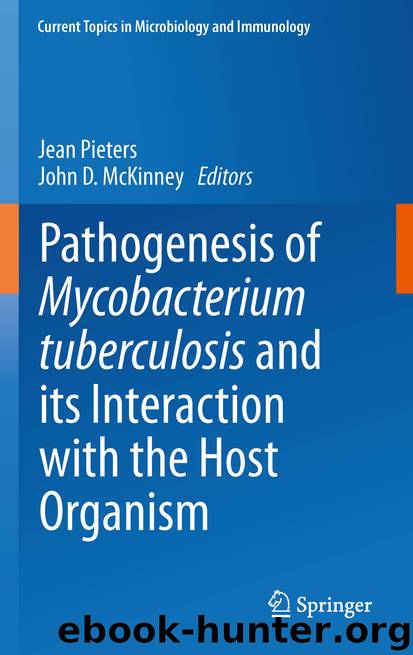Pathogenesis of Mycobacterium tuberculosis and its Interaction with the Host Organism by Jean Pieters & John D. McKinney

Author:Jean Pieters & John D. McKinney
Language: eng
Format: epub
Publisher: Springer Berlin Heidelberg, Berlin, Heidelberg
3.3 ESX-1: An Interplay Between Substrates Essential for Virulence
Since the deletion of RD1 was shown to greatly affect mycobacterial virulence, the associated secretion system ESX-1 has been the object of many studies. A number of studies now indicate that the ESX-1 secretion system is associated with membrane damage/rupture. For example, wildtype Mycobacterium marinum bacteria, but not ESX-1 mutants, can cause lysis of red blood cells upon interaction (Gao et al. 2004). Moreover, a functional ESX-1 system is essential for escape of both M. tuberculosis and M. marinum from the phagosome to the cytosol (Gao et al. 2004; van der Wel et al. 2007; Smith et al. 2008; Simeone et al. 2012). This escape is likely facilitated by rupture of the phagosomal membrane by one of the ESX-1 substrates. EsxA has been postulated to be responsible for this, since purified EsxA was shown to destabilize artificial lipid membranes (de Jonge et al. 2007; Smith et al. 2008). However this theory is not undisputed, because several (non-pathogenic) mycobacterial species do secrete EsxA, but do not escape the phagolysosomal compartment (Houben et al. 2012a). A complicating factor is that any EsxA/B secretion defect in mycobacteria always coincides with impaired secretion of Esp’s, so observed effects could also be indirect. It has been shown that abrogation of EspA secretion specifically without affecting EsxAB secretion results in serious attenuation in macrophage infections (Garces et al. 2010). It is thus well possible that the phagosomal membrane rupture associated with ESX-1 secretion is actually caused by one of the Esp’s or a combination of ESX-1 substrates. Further research should identify the true ESX-1 substrate necessary for phagolysosomal escape.
Interestingly, in M. smegmatis ESX-1 is additionally involved in a completely different process, i.e. specific conjugal DNA transfer mechanism. Disruption of ESX-1 in the donor strain resulted in hyperconjugative mutants (Flint et al. 2004), whereas in the recipient strain a functional ESX-1 system seems to be crucial for conjugation (Coros et al. 2008). Whether specific ESX-1 substrates are involved in this process remains to be determined.
Since ESX-1 secretion was shown to be crucial in a specific step of the mycobacterial infection pathway, it is no surprise that expression of this system seems to be strictly regulated. One important ESX-1 regulator is the two-component system PhoP/R. This two-component systems regulates directly the espACD operon (Walters et al. 2006). As EspA secretion is essential for ESX-1 functioning, PhoP/R therefore also indirectly regulate EsxAB secretion (Frigui et al. 2008; Gonzalo-Asensio et al. 2008).
The espACD operon is also regulated by the repressor Lsr2 (Gordon et al. 2010) and activated by Rv3849. Since this latter protein was suspected to be a secreted substrate of ESX-1, it was named EspR (Raghavan et al. 2008). However, it has been shown recently that EspR is not secreted and actually binds and regulates a large number of genomic loci. A consensus binding motif of EspR was determined, which also corresponds to the region upstream of the espACD operon (Blasco et al. 2012). It therefore seems likely that EspR is a nucleoid-associated protein that performs a more general role in regulation.
Download
This site does not store any files on its server. We only index and link to content provided by other sites. Please contact the content providers to delete copyright contents if any and email us, we'll remove relevant links or contents immediately.
| Administration & Medicine Economics | Allied Health Professions |
| Basic Sciences | Dentistry |
| History | Medical Informatics |
| Medicine | Nursing |
| Pharmacology | Psychology |
| Research | Veterinary Medicine |
Tuesdays with Morrie by Mitch Albom(4729)
Yoga Anatomy by Kaminoff Leslie(4332)
Science and Development of Muscle Hypertrophy by Brad Schoenfeld(4103)
Bodyweight Strength Training: 12 Weeks to Build Muscle and Burn Fat by Jay Cardiello(3939)
Introduction to Kinesiology by Shirl J. Hoffman(3743)
How Music Works by David Byrne(3234)
Sapiens and Homo Deus by Yuval Noah Harari(3029)
The Plant Paradox by Dr. Steven R. Gundry M.D(2581)
Churchill by Paul Johnson(2543)
Insomniac City by Bill Hayes(2520)
Coroner's Journal by Louis Cataldie(2458)
Hashimoto's Protocol by Izabella Wentz PharmD(2350)
The Chimp Paradox by Peters Dr Steve(2340)
The Universe Inside You by Brian Clegg(2113)
Don't Look Behind You by Lois Duncan(2101)
The Immune System Recovery Plan by Susan Blum(2040)
The Hot Zone by Richard Preston(1995)
Endure by Alex Hutchinson(1993)
Woman: An Intimate Geography by Natalie Angier(1909)
